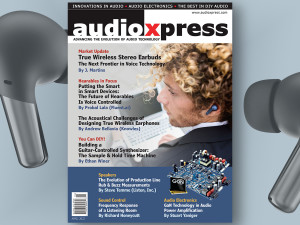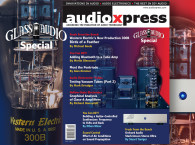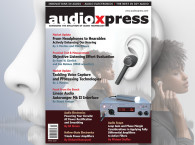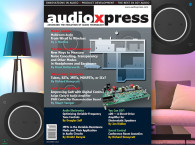 In this April 2022 issue, audioXpress magazine offers a complete Market Update report on True Wireless Stereo (TWS) Earbuds and specifically on voice implementation for this fast-growing product category. In "The Next-Frontier in Voice Technology," J. Martins explores voice communications, voice interfaces, and voice enhancement for TWS product designs, and the available hardware and software building blocks for innovation.
In this April 2022 issue, audioXpress magazine offers a complete Market Update report on True Wireless Stereo (TWS) Earbuds and specifically on voice implementation for this fast-growing product category. In "The Next-Frontier in Voice Technology," J. Martins explores voice communications, voice interfaces, and voice enhancement for TWS product designs, and the available hardware and software building blocks for innovation.
As true wireless earbuds continue to gain augmented audio features, benefiting from the latest advancements in audio processing, active noise cancellation, spatial audio, and other innovations, we continue to see even more acceleration in building the basic blocks toward hearables. And any developer working in TWS earbuds and hearables understands that voice is a key feature in such designs. This Market Update on TWS earbuds summarizes the market scale and trends, the role of sensors and sensor fusion, technologies for voice capture and separation, the latest chips and DSP solutions for hearables and voice processing, and voice software integrations, among many other topics.
To expand our readers' perspective on the topic, Probal Lala (Fluent.ai), writes about how hearables are designed for multi-purpose use including voice transmission, sound amplification, and wireless communications. In "Putting the Smart in Smart Devices: The Future of Hearables is Voice Controlled," the CEO of Fluent.ai details how consumers' expectations for using earbuds everywhere, including for work communications in noisy public environments, is pushing technology to face the challenges at the source, on-device.
A second contribution for a complete perspective on the evolution toward hearables is provided by Andrew Bellavia (Knowles), exploring the current trends as well as the acoustical challenges and solutions for designing true wireless earphones. The article explains the enabling technologies currently converging as the TWS market continues to grow and use cases multiply, with more consumers using wireless earbuds for a diverse and varied set of applications, from listening to podcasts and audiobooks to Internet meetings and interacting with voice assistants.
This issue also offers an important article written by Steve Temme, the founder and President of Boston, MA-based audio measurement experts, Listen, Inc. Anticipating the next software release of SoundCheck, this article offers a complete perspective of the evolution of Rub & Buzz measurements in loudspeakers, headphone drivers, and microspeakers production lines, and how these are being addressed using the next-generation of perceptual algorithms. The article details the development of multiple types of distortion detection, starting with the conventional harmonic distortion methods that, although developed 25 years ago, are still valuable and well-used today. With this evolution overview, Temme offers a valuable comparison with what can be accessed today using modern methods, and what to apply to access production faults, determine thresholds for production yields, or understand the real impact on consumer's perception.

Also highlighted this month is the much expected review of the GaN Systems amplifier evaluation kit by Stuart Yaniger. In this article, he shares his explorations of the features and benefits of GaN (gallium nitride) power semiconductors, and explains why the technology is not only enabling great sounding audio amplifiers but is also bound to completely disrupt the Class-D segment in high power ratings. Yaniger's article includes extensive measurements of this extremely efficient two-channel, 200W per channel (8 ohm) Class-D audio amplifier and companion 400W, continuous power audio-grade SMPS. Clearly targeted at developers, this evaluation board is a complete programmable resource that allows testing multiple input configurations, and offers complete understanding of the amplifier's performance potential with and without feedback loops from the output stage to the controller.
And to make things even more exciting and fun, this edition features Ethan Winer's first article in a fascinating DIY journey through the world of synthesizers. More specifically, a guitar-controlled all-analog synthesizer project that includes a "time machine" sample & hold section, input signal detectors, noise gate, oscillators, envelope generators, filters, signal converters, and more. This first module in this article series is a sample and hold circuit designed to translate the guitar notes to equivalent oscillator frequencies. Other synthesizer modules will be featured in separate articles, allowing builders to try the complete project or any of the separate modules.
In his Sound Control column, Richard Honeycutt writes about the "Frequency Response of a Listening Room" and the challenges and dilemmas that this concept brings when professionals are confronted with it. As it is possible to measure an infinite number of non-identical frequency responses for a give room, Honeycutt explains why without standardization of the meaning of the term "frequency response," as applied to rooms, that term is probably not a useful metric from an engineering standpoint.
The April 2022 issue of audioXpress also offers the first of a two-part article by vacuum tubes expert Mark Driedger, paving the way to our forthcoming annual Glass Audio edition, coming up in May. "An Introduction to Testing Vacuum Tubes (Part 1)" covers the reasons of when and why we will need to test tubes, before exploring the how and provide examples of commercial and DIY testers in Part 2.
 And to all our readers who appreciate the unique sound of tube-based audio equipment, Richard Honeycutt revisits the much debated misconceptions and pointless debates that never truly faded away of "tube vs solid-state." In his Hollow-State Electronics column, Honeycutt explores why the notion of "superiority" of tube or solid-state amplifier comparisons is truly a matter of perception, not necessarily a measurable or objective difference.
And to all our readers who appreciate the unique sound of tube-based audio equipment, Richard Honeycutt revisits the much debated misconceptions and pointless debates that never truly faded away of "tube vs solid-state." In his Hollow-State Electronics column, Honeycutt explores why the notion of "superiority" of tube or solid-state amplifier comparisons is truly a matter of perception, not necessarily a measurable or objective difference.
Remember, audioXpress is published 12 times per year, and available in print and online. Subscribing to the digital online version allows immediate access and is available here: www.audioxpress.com/page/audioXpress-Subscription-Services.html
If you wish to buy a single printed issue or the complete audioXpress archive on USB, from 2000 to 2021 (yes, including the latest issue), just visit our online shop at www.cc-webshop.com
Don't miss out, get your copy of audioXpress right now at www.gotomyxpress.com







